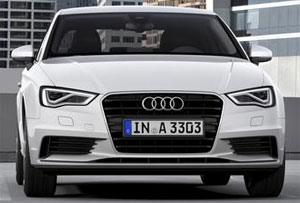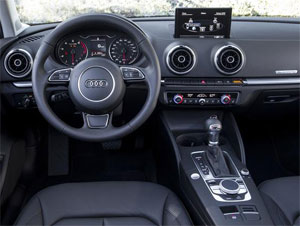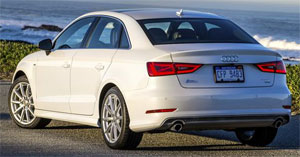2015 Audi A3
Entry-level German sports luxury cars are a tricky proposition here. Most Americans still tend to look at the big-3 German cars as premium items, and then they’re disappointed when they sample the more meat and potatoes compacts and subcompacts from the brand. Well that could be why the Audi A3 has never been a huge seller here. Or, it’s more likely that up to this point the A3 has only been available as a 5-door hatchback. Either way, there’s an all-new A3 sedan in town, and it’s arrives with the U.S.A. as its bull’s-eye.
The 2015 Audi A3 marks an important step for Audi. Proof that they are now taking the American and, perhaps more importantly, the world’s upscale small car market more seriously, spurred along by the recent success of the Mercedes-Benz CLA250.
After all, nothing says conventional like a subcompact sedan, but the A3 4-door is far from mainstream. And while making premium attainable is not a simple undertaking, it’s one that must be completed effectively in order for the A3 to be a success here. And it should be doable as Americans have long embraced the A4 sedan.
 Let’s get things started in the powertrain department, with a choice of 2 corporate Turbo I4s. A 1.8-liter with 170-horsepower and 200 lb-ft. of torque is found in front wheel drive models; and a 2.0-liter with 220-horsepower and 258 lb-ft. provides motivation to all 4 wheels in quattro models. Both come with a 6-speed S tronic dual-clutch automatic; no manual is available.
Let’s get things started in the powertrain department, with a choice of 2 corporate Turbo I4s. A 1.8-liter with 170-horsepower and 200 lb-ft. of torque is found in front wheel drive models; and a 2.0-liter with 220-horsepower and 258 lb-ft. provides motivation to all 4 wheels in quattro models. Both come with a 6-speed S tronic dual-clutch automatic; no manual is available.
Our sample sports the 2.0, which performed admirably at our test track. Quattro makes for a grippy, if a little sluggish, launch off the line; but adequately quick, as we hit 60 in 6.0– seconds flat. We very much welcomed the true dual-clutch transmission over a CVT; still shifts weren’t as quick as expected helping us complete the ¼-mile in 14.6–seconds at 96 miles-per-hour.
While Audi’s sporty DNA shines through, this is clearly not an S model as steering is stone dead. Still there’s a solid and stable feel with just enough of an enjoyable, light weight presence that encourages pushing hard; and the A3 behaves itself well.
An all-aluminum sub-frame with MacPherson struts handles suspension duties up front, with a 4-link setup in the rear with a steel cross member. Brakes are the same for either front or all-wheel-drive A3, with our quattro stopping in a good 124–feet from 60.
This all-new sedan body is built on Volkswagen’s fledgling MQB architecture. Just about every exterior dimension is increased over the previous hatchback. Wheelbase is up more than 2-inches to 103.8. Length and width also see meaningful gains.
 There’s nothing ground breaking with exterior design elements, however, as all recent Audi trademarks are in place, including the large Singleframe grille and LED daytime running lights. Both A3s ride on nice looking 17-inch 5-spoke alloy wheels.
There’s nothing ground breaking with exterior design elements, however, as all recent Audi trademarks are in place, including the large Singleframe grille and LED daytime running lights. Both A3s ride on nice looking 17-inch 5-spoke alloy wheels.
Inside, is a whole new look for the brand. There’s still a premium feel with leather seating and panoramic sunroof standard; but it’s a clear step down from the lavish landscapes of A6 and A8. The wide and flat, simplistic dash design features large circular air vents giving it a sporting, if retro, feel; until you see the very thin navigation screen rise out of the dash. In front of the driver is a 3-spoke steering wheel and plenty of info on the gauge screens.
All controls are driver oriented, and there’s an updated version of Audi’s MMI central control, which we like even more thanks to the new toggle switches and write on feature. Front seats are roomy and comfortable, and while the stretch in wheelbase does allow for more rear seat room, it’s still barely adequate. Trunk space is more than adequate, however, at 10.0 cubic-ft. Convenience features include available Audi connect with 4G LTE connectivity and navigation. But, you’ll have to add the $1,400 Driver Assist Package if you want a back-up camera.
Government Fuel Economy Ratings for our quattro tester are 23-City, 33-Highway, and 27-Combined, and our average of 29.2 miles-per-gallon of Premium was a good one. The Energy Impact Score comes in good also, at 12.2-barrels of annual oil use with 5.4-tons of CO2 emitted.
 Base pricing at $30,795 for the 1.8 and $33,795 for the 2.0 quattro seems right on the money. Though throwing in a back-up camera for that price would really make us happy.
Base pricing at $30,795 for the 1.8 and $33,795 for the 2.0 quattro seems right on the money. Though throwing in a back-up camera for that price would really make us happy.
The Mercedes-Benz CLA250 has proven that an entry-level German sports luxury sedan can indeed have big success in the U.S. if tailored properly. The 2015 Audi A3, with its premium but attainable feel, clearly delivers just as well. So, if you like your steak well-done, but not overdone, order up!
Specifications
- Engine: 2.0-liter
- Horsepower: 220
- Torque: 258 lb-ft.
- 0-60 mph: 6.0 seconds
- 1/4 mile: 14.6 seconds @ 96 mph
- EPA: 23 mpg city/ 33 mpg highway
- CO2 Emissions: 5.4 tons/yr
- Energy Impact: 12.2 barrels of oil/yr
2025 Volkswagen ID. Buzz
Volkswagen Brings Beetlemania Level Of Excitement To Minivan Segment
The duty of upholding Volkswagen’s heritage has most recently been delegated to small legacy car names like Golf and Jetta. But hold on! A much larger, totally modern take on VW’s classic microbus has just buzzed over the horizon— the all-electric ID. Buzz. It’s been at the top of our minds since we first saw the concept back in 2017. Well, it’s finally here, so let’s get our groove into drive!
This 2025 Volkswagen ID. Buzz has indeed created the most buzz around Volkswagen since the Beetle’s return to the U.S. in the late 1990s. We couldn’t drive it anywhere without drawing a crowd. No wonder, just about everyone has a VW Microbus story to tell, and seeing this reimagined version rolling down the street brings back all those memories.
VW really pulled it off as far as we’re concerned, as it looks great without appearing over the top. All the cues are here: Big VW logo front and center, lots of greenhouse including A-pillar windows and mini sliders for the second-row passengers, D-pillar air vents, and two-tone wheels. And while its appearance may be pure retro, its drivetrain is far from it, as the ID. Buzz is all-electric, and unlike the new Beetle, the Buzz does retain the original Microbus’ rear-drive architecture.
Powering those rear wheels is a 210-kW motor drawing juice from a 91-kWh battery for a range of 234 miles; 200-kW max charging will get you to 80% in about 26 minutes. Buyers can add another small 80-kW motor up front for 4motion all-wheel-drive and an increase of total output from 282 to 335 horsepower with a combined 512 lb-ft of torque. It uses the same battery, but range estimates drop just slightly to 231 miles. But while those numbers are modest, we also found them to be quite conservative, as we observed as many as 287 miles available in our all-wheel-drive tester’s gauge display and were on pace for 273 miles in our driving loop.
One throwback theme that may be a turnoff to some is that it’s quite a step up into the Buzz’s front seats, but there’s certainly a commanding view of the road once you climb in. Second row seating can be either a three-place bench or a pair of captain’s chairs, so there’s generous room for seven or six passengers. The captain’s chairs in our Pro S Plus offer good support and very easy access to the third row.
Lots of flexibility too with the option to simply fold the seats or remove them altogether.
With the sliding side doors and a wide opening rear hatch, there’s plenty of access for loading big sport utility amounts of cargo. Lots of flexibility too with the option to simply fold the seats or remove them altogether, and the ability to create a full-length flat floor with a rear cargo shelf that covers some handy removable storage bins. There’s 18.6 cubic-feet of space behind the third row, 75.5 behind the second, and a max of 145.5. That’s more than a Chevrolet Tahoe. For smaller items, there are lots of cubbies throughout the cabin, along with a standard Buzz Box that can be moved to multiple locations.
With a design that prioritizes retro form and modern function over aero efficiency, the 4motion equipped ID. Buzz earns a Fair efficiency rating, using 42-kWh of electricity per 100 miles, and we weren’t sure what to expect at our Mason Dixon test track.
What we found was great torque off the line and drama free launches to 60 in just 5.3 seconds. It was very stable at speed and power delivery stayed steady most of the way down the track until we reached about 90 mph, when it began to taper off just before we finished the quarter-mile in 14.0 seconds flat at 97 mph.
With 1,200-lbs. of battery weight nestled in its 127.5-inch wheelbase, the Buzz felt planted to the pavement through our handling course. There was quite a bit of body roll to deal with, but surprisingly little understeer. In panic braking runs, pedal response was inconsistent, feeling soft at times, pushing back hard at others; but through it all, results were quite good, stopping from 60 in an average of just 108 feet.
Three interior themes are available, this Dune is the brightest, featuring coastal inspired wood optic dash décor, “gray and clay” leatherette surfaces, and a high-mounted central 12.9-inch touchscreen. Pricing starts with a rear-wheel-drive Pro S at $61,545; this Pro S Plus begins at $65,045, add another $4,500 for 4motion, which brings a few extra features along with all-wheel drive.
Retro design with old-school VW charm, modern EV drivetrain, big SUV capacity merged with minivan flexibility; it all comes together in this 2025 Volkswagen ID. Buzz. It’s easily one of the coolest rides of the year and one that will likely keep Volkswagen dealers buzzing for years to come, and that’s something no other people and things mover can say.
Specifications
As Tested
- Motor Setup: Dual-Motor AWD
- Battery Size: 91-kWh
- Horsepower: 335
- Torque: 512 lb-ft
- EPA Range: 231 miles
- 0-60 mph: 5.3 seconds
- 1/4 Mile: 14.0 seconds at 97 mph
- Braking, 60-0: 108 feet
- MW Test Loop: ~ 273 miles













































